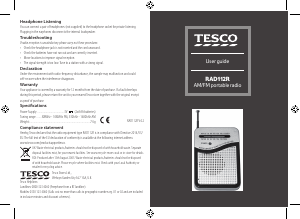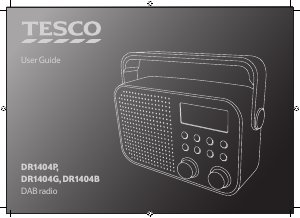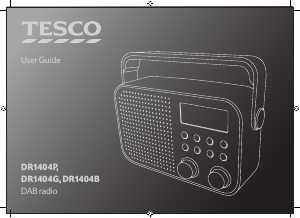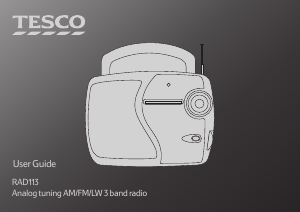
5 6 7 8 9
Tesco Stores Ltd,
Delamare Road, Cheshunt, Herts, EN8 9SL
DR1403 EN V0.4
There is a headphone output jack on the back panel of the
radio. If headphones are connected to this socket for private
listening, the speaker will cut out automatically.
Your Tesco appliance is covered by a warranty for 12 months
from the date of purchase. If a fault develops during this
period, please contact the TESCO electrical help line.
Please have your original purchase receipt with you when you
call. This warranty in no way aects your consumer rights.
Tesco Helplines:
Landlines 0800 323 4060 (Freephone from a BT landline).
Mobiles 0330 123 4060 (Calls cost no more than calls to
geographic numbers eg. 01 or 02 and are included in inclusive
minutes and discount schemes).
TROUBLESHOOTING
HEADPHONES
SPECIFICATIONS
CARE AND MAINTENANCE
DISPOSAL
WARRANTY
Poor quality radio reception
The aerial signal may not be adequate. Try adjusting the
aerial position while watching the signal strength on the
bargraph. Signal strength can be displayed by tuning to a
DAB station and pressing the Info/Menu button until the
signal strength bargraph is displayed.
Few DAB stations are available after moving area
The radio should be reset to renew the station list. Refer to
the ‘Factory Reset’ section on page 7.
Poor quality FM reception
If you are listening to a station with a weak signal, try
changing the Audio Setting to ‘Forced Mono’.
DAB DISPLAY MODES
The bottom line of the display can be switched to show
dierent items of information that may be transmitted with
a DAB station.
Choosing the information display
Press the Info/Menu button repeatedly to change the
information displayed while playing a DAB radio station.
The full range of display options are shown below. Some
stations may not broadcast all of these options.
DLS (Dynamic Label Segment): This is a scrolling message
giving real-time information - song titles, news headlines,
etc.
SIGNAL STRENGTH: This setting will display a signal strength
bargraph. The longer the bargraph, the stronger the signal.
Setting the display to show signal strength is useful when
setting up the aerial for the strongest signal.
PROGRAMME TYPE: This describes the style of the
programme being broadcast.
MULTIPLEX NAME: DAB Digital radio stations are broadcast
in multiplexes. Each multiplex is a bundle of radio stations
transmitted in a single frequency. There are national and
local multiplexes; local ones contain stations specic to your
area. This option displays the name of the multiplex name
that contains the station you are listening to.
MULTIPLEX NUMBER/FREQ: This option will display the
multiplex number and frequency that contains the station
you are listening to.
SIGNAL ERROR RATE: This option will display the level of
signal errors in the current broadcast. The lower the number,
the better the quality of the signal.
BIT RATE: DAB allows broadcasters to vary the BIT RATE (or
the amount by which an audio signal can be compressed)
depending on the type of broadcast. This enables the amount
of stations on a multiplex to be maximised. Speech and News
are often broadcast at a lower Bit Rate; music needs a higher
Bit Rate for good delity.
TIME AND DATE: Time and date are updated by broadcasted
information.
When rst used, your radio scanned the DAB band for
available stations. The station services found were then
stored in your radio’s memory.
You can re-scan the band at any time if you move to a dierent
area or just to refresh the stored list of available stations.
NOTE: On some occasions, when moving to a dierent area,
re-scanning may not fully update the station list. In this case
it may be necessary to reset your radio. (see the ‘Factory reset’
option on page 7).
DAB MENU OPTIONS
Full Scan
Manual Tune
Prune
System
DRC
Scan all DAB bands
Manually tune to a station multiplex
Set DRC values
Prune unused stations from the list
Press Volume/Select
Factory reset
Return all settings to factory original
SW version
Display the software version
Time
Set the clock manually
Backlight
Set the backlight brightness
Press Volume/Select
Press Volume/Select
Press Volume/Select
Press Volume/Select
Press the Tune +
button to select
the next option
Press Volume/Select
Press Volume/Select
Press Volume/Select
Press Volume/Select
Press the Tune +
button to select
the next option
DAB SETTINGS MENU
Your radio has some additional features and options that
may be reached through the Settings Menu.
A complete map of the menu is shown.
To enter the DAB Settings Menu
Set to DAB mode.•
Press and • hold the Info/Menu button.
The menu will be displayed.
Press the • Tune + or Tune - button to step through the
available options.
To choose an option from the menu, press the • Volume/
Select control.
Choose the ‘System’ menu option to open the sub-menu of
system options shown on the menu map.
Full Scan: Select Full Scan to re-scan the entire DAB band
and refresh the station list.
Manual Tuning: Manual tuning enables you to search the
band manually by pressing the Tune + or Tune - button to
step through the multiplex numbers and check if any have
usable signal strength on a bargraph display. Manual tuning
is not necessary in normal operation where scanning will
have established a station list of usable stations.
DRC: DRC is Dynamic Range Compression. Enabling DRC may
improve the sound of DAB radio when listening in a noisy
room.
Prune: If your station list includes stations that you can no
longer receive (you may have moved to a dierent area), you
can select the ‘Prune’ option to remove them and clean up
the Station List.
System>Time: Select the time option to set the clock
manually. This may be useful if you are in an area where it is
not possible to receive DAB radio broadcasts.
You can also choose automatic clock setting options to update
from a DAB station, FM station or any station.
System>Backlight: Select ‘Backlight’, then the ‘Normal
Mode’ or ‘Standby Mode’ sub-option to change the backlight
brightness settings when the radio is operational or set to
Standby.
System>Factory reset: Select the ‘Yes’ sub-option to reset
all the settings of your radio to factory original settings.
The station list will also be cleared and any stored preset
memories will be erased. After a factory reset the radio will
re-scan the band and renew the station list.
System>SW Version: This option will display the version
number of the control software currently installed in your
radio. This will be helpful to a technician who is servicing the
radio.
The bottom line of the display can be switched to show
dierent items of information that may be transmitted with
an FM station.
To change the display mode
Press the Info/Menu button repeatedly to change the
information displayed while playing an FM radio station.
The full range of display options are shown. Some stations
may not broadcast all of these options.
FM DISPLAY MODES
FM MENU OPTIONS
FM SETTINGS MENU
There are also some menu settings that are specic to FM
radio operation. These settings may be changed through the
Settings Menu.
To enter the FM Settings Menu
Set to FM mode.•
Press and • hold the Info/Menu button.
A map of the menu is shown below. The menu is navigated in
the same way as the DAB settings menu.
Scan Setting
System Setting
Audio Setting
MORE DETAIL OF THE FM SETTINGS MENU OPTIONS
Scan Setting: With this menu option you can set the
scanning sensitivity of the FM radio to two dierent levels-
‘Strong stations’ or ‘All stations’. Setting to ‘Strong stations’
will exclude weaker stations resulting in a quicker scan.
If you set to ‘All stations’ the scan will stop at every station
detected, even if the signal is weak.
Audio Setting: This option enables you to set the radio to
‘Forced Mono’ or ‘Stereo Allowed’. Setting Forced Mono may
be useful if the signal is weak and the broadcast is noisy
when listening in stereo via headphones.
System: The System sub-menu options are the same as those
described in the DAB settings section.
CARE AND CLEANING
All care and cleaning operations should be carried out with
the unit unplugged from the mains power and switched o.
The surface of the unit can be cleaned with a barely damp
cloth and then dried carefully. Never use abrasives, abrasive
cloths or chemical solvents .
Supply Voltage, Current : .... 5 V
, 1 A
AC Adapter input: ............... 100-240 V ~, 50-60 Hz, 200 mA
Batteries ............................ 4 x 1.5V
, ‘AA’ type batteries
Frequency range ................ 174-240 MHz (DAB)
........................................... 87.5-108MHz (FM)
Net Weight: ........................ 384 g
Class II construction double insulated.
This product must not be connected to earth.
To prevent possible hearing damage, do not
listen at high volumes for long periods.
UK: Waste electrical products/batteries should
not be disposed of with household waste.
Separate disposal facilities exist, for your nearest
facilities see www.recycle-more.co.uk or in-store
for details.
ROI: Produced after 13th August 2005. Waste
electrical products/batteries should not be
disposed of with household waste. Please recycle
where facilities exist. Check with your Local
Authority or retailer for recycling advice.
You can choose to listen to DAB or FM radio -
Selecting DAB or FM
Press the • DAB/FM button repeatedly to switch between
DAB and FM mode.
To change to the FM band
Press the • DAB/FM button to switch to the FM band.
FM will be displayed.
The radio will play the last FM station you were listening to.
To auto-tune to FM stations
Press and • hold the Tune + or Tune - button to search up
or down for the next station in the band.
The radio will search and the tuning frequency will be displayed
whilst searching.
When a usable station is detected the radio will stop tuning and
play the station. If RDS data is present, the station name and
scrolling radio text will be displayed. If RDS data is not present,
‘No Radiotext’ will be displayed.
To manually tune to FM stations
Press the • Tune + or Tune - button briey to tune up or
down the band in 50kHz steps.
FM stereo/mono
When listening to a weak or distant FM station in stereo via
earphones, there may be a high level of background noise.
In this case, setting mono reception may reduce the level of
background noise.
Press the • Volume/Select control to switch between
mono and stereo reception.
SELECTING DAB OR FM
LISTENING TO FM
Your radio can store up to 10 of your favourite stations as
presets on both the DAB and FM bands for quick recall.
To store a preset
Tune to the station you want to store as a preset.•
Press and • hold the Preset button.
‘Preset Store’ will be displayed.
Press the • Tune + or Tune - button repeatedly to choose
the preset number you want to store.
For each preset number the preset station currently stored will
be displayed or ‘(Empty)’ if none is stored.
Press the • Volume/Select control to conrm if you want
to store the station in the displayed preset number.
To recall any preset
Press the • Preset button briey.
‘Preset Recall’ will be displayed.
Press the • Tune + or Tune - button repeatedly to nd the
preset number you want to play.
Press the • Volume/Select control to play the preset.
The radio will re-tune and the preset number will be displayed.
DAB & FM PRESETS
DLS (Scrolling text)
Multiplex name
Programme type
Multiplex number/frequency
Audio bit rate/encoding
Signal error rate
Date
Time
Signal strength
RDS Radiotext
Stereo/Mono
Frequency
Time
Date
Programme type












Join the conversation about this product
Here you can share what you think about the Tesco DR1403B Radio. If you have a question, first carefully read the manual. Requesting a manual can be done by using our contact form.